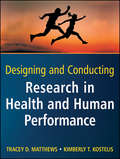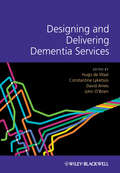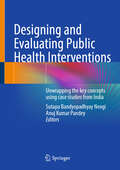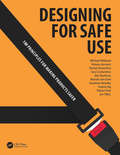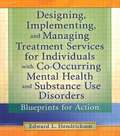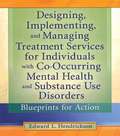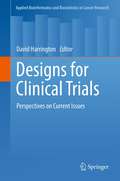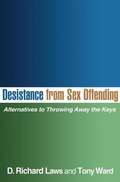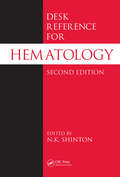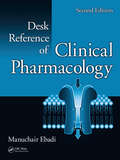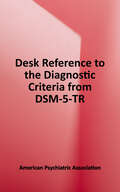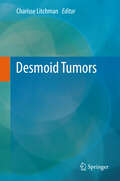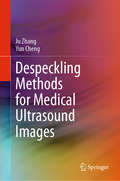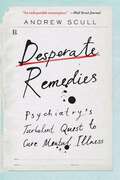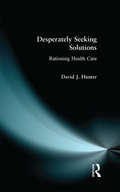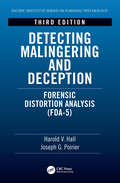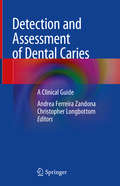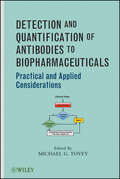- Table View
- List View
Designing and Conducting Research in Health and Human Performance
by Tracey D. Matthews Kimberly T. KostelisDesigning and Conducting Research in Health and Human Performance shows students how to become effective producers and consumers of health and human performance research. The book provides comprehensive coverage of both quantitative and qualitative research methods and includes step-by-step guidance for writing effective research proposals and theses. In addition, the authors show how to read, assess, interpret, and apply published research and how to conduct basic studies in health, physical education, exercise science, athletic training, and recreation. Designing and Conducting Research in Health and Human Performance is filled with illustrative examples that emphasize the real-world applications of research methods. Throughout, the authors draw on a variety of examples that were selected because they provide a context to further the understanding of health and human performance research. Research to Practice examples and Tips are included by the authors to help students better appreciate the book's content. These study aids provide suggestions and additional resources to assist students in understanding the research process. Key Terms, defined and highlighted, enrich each chapter. Chapter Review Questions, designed to help students comprehend and follow best practices in research methods, close each chapter. Online resources and guides developed by the authors to support and enhance students' learning of important research concepts are available.
Designing and Conducting a Forest Inventory - case: 9th National Forest Inventory of Finland
by Matti Katila Juha Heikkinen Helena M. Henttonen Tarja Tuomainen Nina Vainikainen Antti Ihalainen Helena Mäkelä Erkki TomppoThis book demonstrates in detail all phases of the 9th National Forest Inventory of Finland (1996-2003): the planning of the sampling design, measurements, estimation methods and results. The inventory knowledge accumulated during almost one hundred years is consolidated in the book. The purpose of the numerous examples of results is to demonstrate the diversity of the estimates and content of a national forest inventory. The most recent results include the assessment of the indicators describing the biodiversity of forests. The Finnish NFI has been and is a model for many countries worldwide. The methods and results of the book are set in the international context and are applicable globally. The book provides a valuable information source for countries, institutions and researchers planning own inventories as well as modifying the existing ones, or seeking the applicable definitions and estimation methods to use in their own inventories.
Designing and Delivering Dementia Services
by John O'Brien Hugo De Waal David Ames Constantine LyketsosDementia is increasingly and widely recognised as a serious health and social challenge, in the developed world as well as in the developing world. The need therefore to design and implement dementia care services of high quality is becoming more and more vital, particularly given the likelihood of ever increasing demand in a world, which likely sees resources at best remaining at current levels.Designing and Delivering Dementia Services describes current developments in the design and configuration of dementia services. It offers an informative and detailed overview of what constitutes high quality care, considering the circumstances patients and carers may find themselves in.For dementia to get the priority it deserves, a number of factors are important and the book charts the invaluable contributions of various Alzheimer's Associations and Societies: this provides a focus on dementia strategies and plans at national levels: the book reports on the state of affairs regarding such strategies and provides a unique insight into the process of how one of these was developed and implemented.Recognising the need to prove that service developments lead to a higher quality of care, increased productivity and increased efficiency, the book links the resulting picture to service-based research methodologies, with an emphasis on the strengths and limitations of that research.Contributions from 17 countries on 4 continents give an overview of the state of affairs across the world, paying attention to successful - and less successful - initiatives to improve dementia care. The book furthermore provides pragmatic approaches to ensure planning becomes reality, highlights the need for structured workforce development, education and training and describes the opportunities afforded by assistive technology.This book is of prime informative and practical value given that pressures on dementia services are projected to mount across the world against a backdrop of limited resources and expertise.Designing and Delivering Dementia ServicesDefines the problems involved in meeting an increasing demand for dementia care services in a poorer worldMaps initiatives and developments in the design and configuration of these services in a variety of international settingsAnalyses these developments against the background of political and health economic circumstancesProvides a road map of where health services should go in response to this growing challenge.The first book to define, analyse and map initiatives for dementia care services in a time of increasing demand and decreasing resources, this book is essential reading for commissioners, senior clinicians and service planners in health and social care. It will also be of interest to academic researchers involved in qualitative services research as well as quantitative health economic research, health and social care managers and those involved in workforce planning and development.
Designing and Evaluating Public Health Interventions: Unwrapping the key concepts using case studies from India
by Sutapa Bandyopadhyay Neogi Anuj Kumar PandeyThis book covers all aspects of public health interventions, emphasizing the design, implementation, and evaluation of such initiatives. Section I provides information ranging from fundamental concepts of designing an intervention to its implementation and scalability. Section II highlights evidence around interventions to address pressing public health concerns through interesting case studies from India, that offer practical insights for better understanding. This book is relevant for researchers and academicians in public health, epidemiology, health management and economics, health policy, and allied branches. It equips readers to design and analyze interventions to improve practice.
Designing for Inclusion: Inclusive Design: Looking Towards The Future
by Jonathan Lazar Patrick Langdon Ann Heylighen Hua DongThis proceedings book presents papers from the 10th Cambridge Workshops on Universal Access and Assistive Technology. The CWUAAT series of workshops have celebrated a long history of interdisciplinarity, including design disciplines, computer scientists, engineers, architects, ergonomists, ethnographers, ethicists, policymakers, practitioners, and user communities. This reflects the wider increasing realisation over the long duration of the series that design for inclusion is not limited to technology, engineering disciplines, and computer science but instead requires an interdisciplinary approach. The key to this is providing a platform upon which the different disciplines can engage and see each other’s antecedents, methods, and point of view. This proceedings book of the 10th CWUAAT conference presents papers in a variety of topics including: * Reconciling usability, accessibility, and inclusive design; * Designing inclusive assistive and rehabilitation systems; * Designing cognitive interaction with emerging technologies; * Designing inclusive architecture; * Data mining and visualising inclusion; * Legislation, standards, and policy in inclusive design; * Situational inclusive interfaces; and * The historical perspective: 20 years of CWUAAT. CWUAAT has always aimed to be inclusive in the fields that it invites to the workshop. We must include social science, psychologies, anthropologies, economists, politics, governance, and business. This requirement is now energised by imminent new challenges arising from techno-social change. In particular, artificial intelligence, wireless technologies, and the Internet of Things generate a pressing need for more socially integrated projects with operational consequences on individuals in the built environment and at all levels of design and society. Business cases and urgent environmental issues such as sustainability and transportation should now be a focus point for inclusion in an increasingly challenging world. This proceedings book continues the goal of designing for inclusion, as set out by the CWUAAT when it first started.
Designing for Inclusion: Inclusive Design: Looking Towards the Future
by Jonathan Lazar Patrick Langdon Ann Heylighen Hua DongThis proceedings book presents papers from the 10th Cambridge Workshops on Universal Access and Assistive Technology. The CWUAAT series of workshops have celebrated a long history of interdisciplinarity, including design disciplines, computer scientists, engineers, architects, ergonomists, ethnographers, ethicists, policymakers, practitioners, and user communities. This reflects the wider increasing realisation over the long duration of the series that design for inclusion is not limited to technology, engineering disciplines, and computer science but instead requires an interdisciplinary approach. The key to this is providing a platform upon which the different disciplines can engage and see each other’s antecedents, methods, and point of view.This proceedings book of the 10th CWUAAT conference presents papers in a variety of topics includingReconciling usability, accessibility, and inclusive design;Designing inclusive assistive and rehabilitation systems;Designing cognitive interaction with emerging technologies;Designing inclusive architecture;Data mining and visualising inclusion;Legislation, standards, and policy in inclusive design;Situational inclusive interfaces; andThe historical perspective: 20 years of CWUAAT.CWUAAT has always aimed to be inclusive in the fields that it invites to the workshop. We must include social science, psychologies, anthropologies, economists, politics, governance, and business. This requirement is now energised by imminent new challenges arising from techno-social change. In particular, artificial intelligence, wireless technologies, and the Internet of Things generate a pressing need for more socially integrated projects with operational consequences on individuals in the built environment and at all levels of design and society. Business cases and urgent environmental issues such as sustainability and transportation should now be a focus point for inclusion in an increasingly challenging world. This proceedings book continues the goal of designing for inclusion, as set out by the CWUAAT when it first started.
Designing for Safe Use: 100 Principles for Making Products Safer
by Jonathan Kendler Michael Wiklund Jon Tilliss Cory Costantino Kimmy Ansems Valerie Ng Ruben Post Rachel Aronchick Alix Dorfman Brenda Van GeelHow do you prevent a critical care nurse from accidentally delivering a morphine overdose to an ill patient? Or ensure that people don't insert their arm into a hydraulic mulcher? And what about enabling trapped airline passengers to escape safely in an emergency? <P><P>Product designers and engineers face myriad such questions every day. Failure to answer them correctly can result in product designs that lead to injury or even death due to use error. Historically, designers and engineers have searched for answers by sifting through complicated safety standards or obscure industry guidance documents. <P><P>Designing for Safe Use is the first comprehensive source of safety-focused design principles for product developers working in any industry. <P><P>Inside you’ll find 100 principles that help ensure safe interactions with products as varied as baby strollers, stepladders, chainsaws, automobiles, apps, medication packaging, and even airliners. You’ll discover how protective features such as blade guards, roll bars, confirmation screens, antimicrobial coatings, and functional groupings can protect against a wide range of dangerous hazards, including sharp edges that can lacerate, top-heavy items that can roll over and crush, fumes that can poison, and small parts that can pose a choking hazard. <P><P>Special book features include: <li>Concise, illustrated descriptions of design principles <li>Sample product designs that illustrate the book’s guidelines and exemplify best practices <li>Literature references for readers interested in learning more about specific hazards and protective measures <li>Statistics on the number of injuries that have arisen in the past due to causes that might be eliminated by applying the principles in the book <P><P>Despite its serious subject matter, the book’s friendly tone, surprising anecdotes, bold visuals, and occasional attempts at dry humor will keep you interested in the art and science of making products safer. Whether you read the book cover-to-cover or jump around, the book’s relatable and practical approach will help you learn a lot about making products safe. <P><P>Designing for Safe Use is a primer that will spark in readers a strong appreciation for the need to design safety into products. This reference is for designers, engineers, and students who seek a broad knowledge of safe design solutions. .
Designing, Implementing, and Managing Treatment Services for Individuals with Co-Occurring Mental Health and Substance Use Disorders
by Edward L. HendricksonThe book is a single resource for substance abuse and mental health professionals that provides a broad overview of current bottlenecks, such as resource utiization, staff expertise, funding, etc. and suggests a variety of options concerning how each can be addressed.
Designing, Implementing, and Managing Treatment Services for Individuals with Co-Occurring Mental Health and Substance Use Disorders: Blueprints for Action
by Edward L. HendricksonYour blueprint to develop and manage effective co-occurring treatment programs!Sequential or parallel treatments for co-occurring disorders are much less effective than a quality co-occurring treatment program. Most mental health and substance abuse professionals know how to provide an effective program for individuals with a substance use or mental health disorder, but few are aware of the issues involved in providing services for those with dual diagnosis. Designing, Implementing, and Managing Treatment Services for Individuals with Co-Occurring Mental Health and Substance Use Disorders: Blueprints for Action gives you with the tools you need to develop an effective program specific to co-occurring treatment as well as to implement and manage the program's services. Author Edward Hendrickson shares his knowledge from over two decades of developing and implementing co-occurring treatment services. Designing, Implementing, and Managing Treatment Services for Individuals with Co-Occurring Mental Health and Substance Use Disorders: Blueprints for Action is thorough, insightful, and informative, covering all facets of plan and execution, helping you form strategies to address a co-occurring treatment program&’s unique issues. The book examines the historical basis of the current dual treatment system to provide the philosophical tenets the program must follow and the essential qualities for an effective treatment program. It explores the issues in creating a new program or expanding an existing one, as well as the mechanics of day-to-day management. Helpful appendices, tables, and case examples illustrate the discussion.Designing, Implementing, and Managing Treatment Services for Individuals with Co-Occurring Mental Health and Substance Use Disorders: Blueprints for Action discusses: developing the necessary infrastructure for integrated treatment programs the eight essential qualities for an effective treatment program choosing a target population identifying specific services to implement implementation of services in an existing treatment setting implementation of services in a non-mental health or substance abuse setting hiring and training staff clinical supervision and human resource development program management issues multilevel and multi-organization systems steps to ensure program survivalDesigning, Implementing, and Managing Treatment Services for Individuals with Co-Occurring Mental Health and Substance Use Disorders: Blueprints for Action is more than an instructional text for students; it is an essential resource for any substance abuse and mental health professional considering implementing a co-occurring treatment program.
Designs for Clinical Trials
by David HarringtonThis book will examine current issues and controversies in the design of clinical trials, including topics in adaptive and sequential designs, the design of correlative genomic studies, the design of studies in which missing data is anticipated. Each chapter will be written by an expert conducting research in the topic of that chapter. As a collection, the chapters would be intended to serve as a guidance for statisticians designing trials.
Desistance from Sex Offending
by D. Richard Laws Tony WardThis book offers a fresh perspective on treating a population that is often demonized by policymakers, the public, and even clinicians. The authors argue that most sex offenders are "people like us," with the potential to lead meaningful, law-abiding lives if given a chance and appropriate support. They describe an empirically and theoretically grounded rehabilitation approach, the Good Lives Model, which can be integrated with the assessment and intervention approaches that clinicians already use. Drawing on the latest knowledge about factors promoting desistance from crime, the book discusses how encouraging naturally occurring desistance processes, and directly addressing barriers to community reintegration, can make treatment more effective and long lasting.
Desk Reference for Hematology
by N. K ShintonA cross between a dictionary and an encyclopedia, Desk Reference for Hematology, Second Edition presents a concise yet thorough examination of hematology and its relationship with other systems and disorders. The 1500 alphabetically listed articles provide quick and easy access to expert information, the 150 tables put precise data at your f
Desk Reference of Clinical Pharmacology
by Manuchair EbadiSince the publication of the bestselling first edition of CRC Desk Reference of Clinical Pharmacology, dramatic discoveries in molecular medicine along with rapid technological advances have revolutionized the diagnosis and resulted in new medications to be used in the treatment of a broad range of human diseases. To stay abreast of these ra
Desk Reference to the Diagnostic Criteria from DSM-5-TR
by American Psychiatric AssociationThe Desk Reference to the Diagnostic Criteria From DSM-5-TR is a concise, affordable companion to the ultimate psychiatric reference, DSM-5-TR. It includes the fully revised diagnostic classification, as well as all the diagnostic criteria from DSM-5-TR in an easy-to-use format. This handy reference provides quick access to the information essential to making a diagnosis. Designed to supplement DSM-5-TR, this convenient guide will assist all mental health professionals as they integrate the DSM-5-TR diagnostic criteria into their diagnoses. The Diagnostic and Statistical Manual of Mental Disorders stands alone as the most authoritative reference available for clinical practice in the mental health field. The Desk Reference to the Diagnostic Criteria From DSM-5-TR distills the most crucial, updated diagnostic information from this volume to provide clinicians with an invaluable resource for effectively diagnosing mental disorders, ranging from the most prevalent to the least common.
Deskilling Migrant Women in the Global Care Industry
by Sondra CubanThis book explores the human geographies of skilled migration, specifically the practices, dispositions, relationships, and resources of professional women who participate in the global care industry.
Desmoid Tumors
by Charisse LitchmanDesmoid Tumors (DT), also called Aggressive Fibromatoses, are a rare fibroblastic proliferative disease, with an incidence of 2 to 4 new cases per million people per year. Despite the absence of a metastatic potential, DT cause significant morbidity and at times mortality due to its locally invasive behaviour. The anatomical locations can be abdominal, extra-abdominal (often in the extremities) and intra-abdominal. This book is the first manuscript dedicated entirely to Desmoid Tumors. Written by prominent clinicians, researchers and advocacy group experts, patients and professionals alike will find this to be a comprehensive review. Clinical presentation, imaging guidelines and treatment paradigms are highlighted. Both the sporadic and heredity forms (Familial Adenomatous Polyposis) will be discussed. A thorough discussion on the unique issues in children with DT is included. A portion of the book will address the role of the APC gene, the β-catenin protein and the role of mutations in the genesis of DT. Emerging cutting edge research techniques will be revealed. Also included is a thoughtful discussion on the controversial labelling of Desmoid Tumors as benign and the consequences of such a designation. The role of advocacy groups in supporting research and in promoting awareness of rare diseases such as DT will be outlined. This book will serve as basis to prepare clinicians, researchers and patients to embark on the quest for a cure for Desmoid Tumors.
Despeckling Methods for Medical Ultrasound Images
by Ju Zhang Yun ChengBased upon the research they have conducted over the past decade in the field of denoising processes for medical ultrasonic imaging, in this book, the authors systematically present despeckling methods for medical ultrasonic images. Firstly, the respective methods are reviewed and divided into five categories. Secondly, after introducing some basic mathematical tools such as wavelet and shearlet transforms, the authors highlight five recently developed despeckling methods for medical ultrasonic images. In turn, simulations and experiments for clinical ultrasonic images are presented for each method, and comparison studies with other well-known existing methods are conducted, showing the effectiveness and superiority of the new methods. Students and researchers in the field of signal and image processing, as well as medical professionals whose work involves ultrasonic diagnosis, will greatly benefit from this book. Familiarizing them with the state of the art in despeckling methods for medical ultrasonic images, it offers a useful reference guide for their study and research work.
Desperate Remedies: Psychiatry’s Turbulent Quest to Cure Mental Illness
by Andrew ScullA sweeping history of American psychiatry—from prisons to hospitals to the lab to the analyst’s couch—by the award-winning author of Madness in Civilization. For more than two hundred years, disturbances of the mind—the sorts of things that were once called “madness”—have been studied and treated by the medical profession. Mental illness, some insist, is a disease like any other, whose origins can be identified and from which one can be cured. But is this true? In this masterful account of America’s quest to understand and treat everything from anxiety to psychosis, one of the most provocative thinkers writing about psychiatry today sheds light on its tumultuous past. Desperate Remedies brings together a galaxy of mind doctors working in and out of institutional settings: psychologists and psychoanalysts, neuroscientists, and cognitive behavioral therapists, social reformers and advocates of mental hygiene, as well as patients and their families desperate for relief. Andrew Scull begins with the birth of the asylum in the reformist zeal of the 1830s and carries us through to the latest drug trials and genetic studies. He carefully reconstructs the rise and fall of state-run mental hospitals to explain why so many of the mentally ill are now on the street and why so many of those whose bodies were experimented on were women. In his compelling closing chapters, he reveals how drug companies expanded their reach to treat a growing catalog of ills, leading to an epidemic of over-prescribing while deliberately concealing debilitating side effects. Carefully researched and compulsively readable, Desperate Remedies is a definitive account of America’s long battle with mental illness that challenges us to rethink our deepest assumptions about who we are and how we think and feel.
Desperately Seeking Solutions: Rationing Health Care
by David J. HunterFollowing the Governments health reforms in 1991 rationing has been put firmly on the agenda. This book identifies and clarifies the numerous political and ethical issues surrounding rationing in healthcare. Drawing upon international examples it offers a critical overview of the approaches to rationing and makes practical proposals for its management.Desperately Seeking Solutions challenges the assumption that all health services are inherently subject to rationing as demand invariably outstrips supply and examines this within a comparative framework. The author critically evaluates the extent to which rationing has always existed and should exist within the NHS, although until recently it operated on an implicit rather than explicit basis and was bound up with clinical judgements rather than purely financial considerations. The author questions whether calls for explicit rationing are actually desirable and potentially feasible.
Destigmatisation of People Living with HIV/AIDS in China (A Sociological View of AIDS)
by Xiaoping WangAfter reviewing related theories on stigmatisation of people living with HIV/AIDS (PLWHA), this book applies social exclusion theory, actor theory and stigma theory to the study of social mechanisms of stigmatisation of PLWHA in China to show the influence and mechanism of stigmatisation on them, and tries to construct the policy framework to tackle stigmatisation from the perspective of welfare pluralism. Qualitative analysis was used and data was obtained during the field interview. Thirty PLWHA and seventeen healthy people (non-infected people and staff of ASO Service Organizations) were selected by using random sampling and snowball sampling for semi-structured depth interviews. The research examines the treatments and living conditions of those PLWHA, aiming to explore the influence of HIV on them in education, employment, medical care, economy, welfare and social relations. The book is intended for graduate students, researchers interested in this field and relevant policymakers.
Destroy Me: A twisty and addictive psychological thriller from a kindle bestseller
by Karen ColeAn addictive psychological thriller from a kindle bestseller. For fans of Karin Slaughter and Erin Kelly.SOME SECRETS ARE BEST LEFT BURIED...Cat panics when she sees a photofit of a murder suspect flash up on the news. It looks exactly like her, and to make matters worse, the victim is her childhood best friend, Charlie. The following day, the police arrive at her doorstep to question her. She hadn't seen or spoken to Charlie in years, but could the secrets of their past finally be coming back to haunt her?Desperate to find out who gave the police her description and to protect her five-year-old son, Cat investigates. She knows she is innocent and will stop at nothing to prove it. But some secrets are best left buried...*******See what readers are saying about Karen Cole:'Every time I thought I had it sussed a curveball was thrown. Beautifully dark and compelling'Caz, Amazon reviewer'If you like Karin Slaughter you will love this!'Cath, Amazon reviewer'I was constantly guessing throughout and I still didn't see that ending coming even though the clues are there!'Chanel, Amazon reviewer'I absolutely loved this book. I could never have guessed the outcome'Annie, Amazon reviewer
Destroying Sanctuary: The Crisis In Human Service Delivery Systems
by Sandra L. BloomFor the last thirty years, the nation's mental health and social service systems have been under relentless assault, with dramatically rising costs and the fragmentation of service delivery rendering them incapable of ensuring the safety, security, and recovery of their clients. The resulting organizational trauma both mirrors and magnifies the trauma-related problems their clients seek relief from. Just as the lives of people exposed to chronic trauma and abuse become organized around the traumatic experience, so too have our social service systems become organized around the recurrent stress of trying to do more under greater pressure: they become crisis-oriented, authoritarian, disempowered, and demoralized, often living in the present moment, haunted by the past, and unable to plan for the future. <p><p> Complex interactions among traumatized clients, stressed staff, pressured organizations, and a social and economic climate that is often hostile to recovery efforts recreate the very experiences that have proven so toxic to clients in the first place. Healing is possible for these clients if they enter helping, protective environments, yet toxic stress has destroyed the sanctuary that our systems are designed to provide. <p><p> This thoughtful, impassioned critique of business as usual begins to outline a vision for transforming our mental health and social service systems. Linking trauma theory to organizational function, Destroying Sanctuary provides a framework for creating truly trauma-informed services. The organizational change method that has become known as the Sanctuary Model lays the groundwork for establishing safe havens for individual and organizational recovery. The goals are practical: improve clinical outcomes, increase staff satisfaction and health, increase leadership competence, and develop a technology for creating and sustaining healthier systems. Only in this way can our mental health and social service systems become empowered to make a more effective contribution to the overall health of the nation. <p><p> Destroying Sanctuary is a stirring call for reform and recovery, required reading for anyone concerned with removing the formidable barriers to mental health and social services, from clinicians and administrators to consumer advocates.
Detecting Malingering and Deception: Forensic Distortion Analysis (FDA-5) (Pacific Institute Series on Forensic Psychology)
by Harold V. Hall Joseph PoirierDetecting Malingering and Deception: Forensic Distortion Analysis (FDA-5), Third Edition maintains the tradition of the prior two editions, following the Forensic Distortion Analysis (FDA) model. Fully updated since the last edition nearly 20 years ago, the book continues to serve as comprehensive volume on deception and distortion in forensic, clinical and several specialized contexts. As with the previous editions, the book presents a model of deception intended to be utilized and applied by the qualified evaluator. The proposed model covers targets of the faker, response styles show, and methods to detect the deception. The goal is to summarize the historical and latest information on distortion detection, to present guidelines for detecting deception that include variable accuracy rates based on different detection techniques, and to stimulate further research of effective methods of deception detection. Recommendations and guidelines for the practicing clinician are offered throughout the book, including real-world cases to inform and enlighten, particularly in unique cases or those in which the certain outcomes are unexpected. Key Features: Outlines the role of the forensic professional in applying and integrating methods assessment in deception and distortion Provides base-rates for deception-related behavior and events, especially useful in report writing or courtroom testimony as an expert witness Presents the latest advances in methodology and technology to assist in the search for ground truth in applied settings and situations Applies forensic distortion analysis to evaluate the deception-related findings and statements of other professionals involved in a particular case New coverage includes sections and chapters on deception analysis for collectivities, including media groups, contemporary politics, cross-national corporations, conflict, and terrorism Detecting Malingering and Deception incorporates the latest research, providing practical application to utilize information and evaluative methods as they pertain to deception-related settings and situations. Sample reports and extensive graphs, tables, charts, and histograms are provided, and every chapter has been updated with new studies and investigations. The Third Edition boasts six new chapters of coverage to expand the exploration of deception addressing advances in the field, and our current understanding of the phenomenon.
Detection and Assessment of Dental Caries: A Clinical Guide
by Andrea Ferreira Zandona Christopher LongbottomThis book explains how to optimize clinical conditions for detection of the earliest visible signs of dental caries and how best to assess caries activity as a basis for effective management. The available evidence from the literature on detection criteria and methods is distilled and placed in a clinical context to facilitate implementation in clinical practice. Guidance is offered on removal of the dental biofilm and the potential impact of various factors on the performance of different caries detection devices. The histological changes that occur during the caries process and their effect on the clinical appearance of caries lesions are explained. In addition, several caries classification systems based on visual detection criteria and designed to allow staging are presented. Consideration is also given to currently marketed detection aids, including methods involving light fluorescence, transillumination, and radiography. In each case, a summary of the detection performance, based on available supporting evidence, is tabulated together with advice on appropriate clinical application. The reader will find the text to be clearly written and informative, with many supporting clinical images.
Detection and Quantification of Antibodies to Biopharmaceuticals
by Michael G. ToveyThe definitive book on the neutralization of recombinant biopharmaceuticalsRecombinant biopharmaceuticals are an important tool for treating a range of illnesses; however, their efficacy can be severely impaired by their immunogenicity. When introduced into the body, these pharmaceuticals can cause the immune system to produce anti-drug antibodies (ADAs) that neutralize their effects.The first and only book to cover neutralization in connection with biopharmaceuticals and the measurement and application of neutralizing antibodies in modern medicine at any real length, Detection and Quantification of Antibodies to Biopharmaceuticals: Practical and Applied Considerations offers a comprehensive and in-depth look at all the principal aspects of the detection and quantification of antibodies that are essential to understanding and responding to the challenges they present.Bringing together a large-scale review of neutralization and biopharmaceuticals and the ability to measure, detect, and apply antibodies to modern science and medicine with international regulatory perspectives, the expectations of regulatory authorities, and the strengths and weaknesses of various assays, the book describes several novel ideas for detecting ADAs.Designed to serve as a resource for biopharmaceutical drug development, the book provides biotechnology companies and pharmaceutical drug development specialists, as well as non-experts, with key insights into the design, optimization, and qualification of assays, the establishment of sampling strategies, the choice of appropriate assay end-points, and data analysis for the detection and quantification of neutralizing antibodies.
